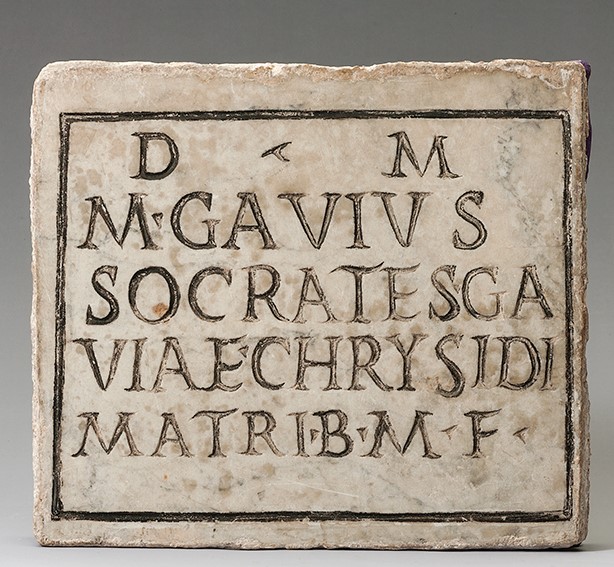Title: Marble Funerary Inscription - 1971.03
Acquisition number: 1971.03
Author or editor: J.R. Green
Culture or period: Roman Imperial
Date: c. 1st - 2nd century AD.
Material: Stone - Marble
Object type: Inscriptions - Funerary
Dimensions: 240mm (w) × 210mm (h)
Origin region or location: Italy
Origin city: Rome
Display case or on loan: 6
Keywords: Roman, Imperial, Funerary, Inscription, Gauia Chrysis, M Gauius Socrates
d’Orville, Sicula ii, 590 no. 31; CIL VI.3 (1886), no. 18920; Folio Fine Art Ltd (London), Writing and Lettering in Antiquity (October 1970) no. 49 (ill.); J.R. Green with B. Rawson, Catalogue of Antiquities in the Australian National University, A.N.U. (Canberra, 1981) 117.
1971.03
Marble Funerary Inscription
Purchased; said to have been found in Rome. Ht 21cm; width 24cm.
Intact and the surface well preserved. Rather grey, slightly mottled marble.
D M
M.GAVIVS
SOCRATES GA
VIAE.CHRYSIDI
MATRI.B.M.F.
“To the departed spirit of Gauia Chrysis: set up by M. Gauius Socrates for his well-deserving mother.”
The son takes his family name, Gauius, from his mother. Without knowing the father’s family name, we cannot say much; but if the father’s name was different (probably, as it is not a common name) the child is illegitimate. Both mother and son have Greek cognomina (personal names), which was common amongst the lower classes of Rome. This may indicate ex-slave status for one or both and that the family was of Eastern Mediterranean origin. For other examples of the name Chrysis, see H. Solin, Die stadtrömischen Sklavennamen. Ein Namenbuch, ii (Stuttgart 1996) 534, and of Socrates, 260-261.
Probably first or second century AD. One may note the handling of the horizontals of the letters. The black colouring in the letters is modern.
d’Orville, Sicula ii, 590 no. 31; CIL VI.3 (1886), no. 18920; Folio Fine Art Ltd (London), Writing and Lettering in Antiquity (October 1970) no. 49 (ill.); J.R. Green with B. Rawson, Catalogue of Antiquities in the Australian National University, A.N.U. (Canberra, 1981) 117.
